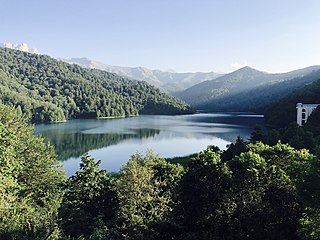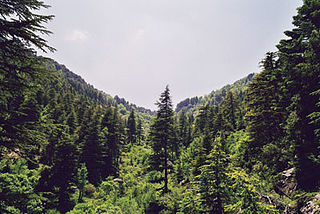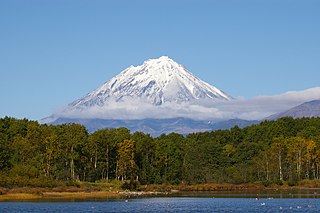
The Caucasian moose, also known as the Caucasian elk is an extinct subspecies of moose found in the Caucasus Mountains of Eastern Europe and Asia Minor, in modern-day European Russia, Armenia, Azerbaijan, Georgia, and eastern Turkey.

Fauna of Azerbaijan or animal kingdom of Azerbaijan refers to the diversity of various types of animals, which inhabit and populate a defined ground or water area in Azerbaijan.

Bioparco di Roma is a 17-hectare (42-acre) zoological garden located on part of the original Villa Borghese estate in Rome, Italy. There are 1,114 animals of 222 species maintained.
National parks of Azerbaijan are run by the Ministry of Ecology and Natural Resources in the Republic of Azerbaijan. The first national park established was Zangezur National Park in 2003. Since then a further 9 national parks have been established; the most recent being the Gizilaghaj National Park in 2018.

Göygöl National Park — is a national park of Azerbaijan. It was established in an area in Goygol Rayon administrative district on April 1, 2008 on the basis of the former "Goy Gol State Reserve" that was established in 1925 and which it superseded, on a surface area of 12,755 hectares (127.55 km2). It was enlarged from 6,739 hectares (67.39 km2) of the former state reserve to its current surface area as a national park.

The Caucasus mixed forests is a temperate broadleaf and mixed forests ecoregion in the Caucasus Mountains, as well as the adjacent Lesser Caucasus range and the eastern end of the Pontic Mountains.

The Yerevan Zoo, also known as the Zoological Garden of Yerevan, is a 35-hectare (86-acre) zoo established in 1940 in Yerevan, Armenia.
The wildlife of Iran include the fauna and flora of Iran.

The wildlife of Armenia includes, in addition to plants, wild boars, porcupines, various lizards, snakes and numerous species of birds. Endangered species living in Armenia are the Caucasian bear, Caucasian bearded goat, the Armenian mouflon (sheep) and the leopard.

The wildlife of Azerbaijan consists of its flora and fauna and their natural habitats.

The wildlife of Jordan includes its flora and fauna and their natural habitats. Although much of the country is desert, it has several geographic regions, each with a diversity of plants and animals adapted to their own particular habitats. Fossil finds show that in Palaeolithic times, the region had Syrian brown bears, Asiatic lions, zebras, Asian elephants, and rhinoceroses, but these species are all now extinct in this region.

The fauna of Europe is all the animals living in Europe and its surrounding seas and islands. Europe is the western part of the Palearctic realm. Lying within the temperate region, the wildlife is not as rich as in the hottest regions, but is nevertheless diverse due to the variety of habitats and the faunal richness of Eurasia as a whole.

Horsh Ehden is a nature reserve located in North Lebanon. It contains a forest of the cedar of Lebanon, making it a part of the country's cultural and natural heritage. Located on the northwestern slopes of Mount Lebanon with high precipitation, it hosts numerous rare and endemic plants. Stands of cedars also include a mixed forest of juniper, fir, and the country's last protected community of wild apple trees. In the forest are endangered eastern imperial eagles or Bonelli's eagles, gray wolves, wildcats, golden jackals, and red foxes. Valleys and gorges also have wild orchids, salamanders, mushrooms, and other flora and fauna.

Vashlovani National Park is a national park located in the eastern part of Georgia, and was established in 1935 to preserve its unique shallow forests. In April 2003 the reserve's area was expanded to 84.80 km2 (32.74 sq mi) and Vashlovani National Park was made.

The wildlife of Russia inhabits terrain that extends across 12 time zones and from the tundra region in the far north to the Caucasus Mountains and prairies in the south, including temperate forests which cover 70% of the country. Russia's forests comprise 22% of the forest in the world as well as 33% of all temperate forest.

Khosrov Forest State Reserve, is a nature reserve in Ararat Province of Armenia. The reserve is one of the oldest protected areas in the world having a history of about 1,700 years. It was founded in the 4th century (334–338) by the order of king Khosrov Kotak, who gave it his name. It was founded to improve the natural climatic conditions of adjacent territories of Artashat – the capital city of Armenia of the given period and the newly established city of Dvin to ensure conservation and enrichment of flora and fauna; serve as a ground for royal hunting, military exercises and entertainment.
The Geno Biosphere Reserve, with a total area of 27,500 hectares, situated in the Hormozgan province of Iran. It has been designated as a protected area by the Iranian Department of Environment in 1976.

The wildlife of Chechnya includes a range of flora, fauna, and funga as reflected by its varying topographic and climatic conditions, with the Greater Caucasus to the south, the foreland zone the Terek and Sunza river valleys in the west and east, and the rolling plains of Nogai steppe in the north. Lake Kezenoyam in Chechnya is near the border with Dagestan and can sustain plankton growth. Salmo ezenami, a rare species of trout now critically endangered due to introduction of the invasive species European chub, is native only to this lake and is therefore endemic to Lake Kezenoyam.

The Tusheti National Park in eastern Georgia is one of the eight new protected areas approved by Parliament of Georgia on 22 April 2003.

















